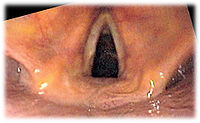
Photo from wikipedia
Introduction Previous studies suggest improved intubation success using video laryngoscopy (VL) vs direct laryngoscopy (DL), yet recent randomized trials have not shown clear benefit of one method over the other.… Click to show full abstract
Introduction Previous studies suggest improved intubation success using video laryngoscopy (VL) vs direct laryngoscopy (DL), yet recent randomized trials have not shown clear benefit of one method over the other. These studies, however, have generally excluded difficult airways and rapid sequence intubation. In this study we looked to compare first-pass success (FPS) rates between VL and DL in adult emergency department (ED) patients with difficult airways. Methods We conducted a secondary analysis of prospectively collected observational data in the National Emergency Airway Registry (NEAR) (January 2016–December 2018). Variables included demographics, indications, methods, medications, devices, difficult airway characteristics, success, and adverse events. We included adult ED patients intubated with VL or DL who had difficult airways identified by gestalt or anatomic predictors. We stratified VL by hyperangulated (HAVL) vs standard geometry VL (SGVL). The primary outcome was FPS, and the secondary outcome was comparison of adverse event rates between groups. Data analyses included descriptive statistics with cluster-adjusted 95% confidence intervals (CI). Results Of 18,123 total intubations, 12,853 had a predicted or identified anatomically difficult airway. The FPS for difficult airways was 89.1% (95% CI 85.9–92.3) with VL and 77.7% (95% CI 75.7–79.7) with DL (P <0.00001). The FPS rates were similar between VL subtypes for all difficult airway characteristics except airways with blood or vomit, where SGVL FPS (87.3%; 95% CI 85.8–88.8) was slightly better than HAVL FPS (82.4%; 95% CI, 80.3–84.4). Adverse event rates were similar except for esophageal intubations and vomiting, which were both less common in VL than DL. Esophageal intubations occurred in 0.4% (95% CI 0.1–0.7) of VL attempts and 1.5% (95% CI 1.1–1.9) of DL attempts. Vomiting occurred in 0.6% (95% CI 0.5–0.7) of VL attempts and 1.4% (95% CI 0.9–1.9) of DL attempts. Conclusion Analysis of the NEAR database demonstrates higher first-pass success with VL compared to DL in patients with predicted or anatomically difficult airways, and reduced rate of esophageal intubations and vomiting.
Journal Title: Western Journal of Emergency Medicine
Year Published: 2022
Link to full text (if available)
Share on Social Media: Sign Up to like & get
recommendations!